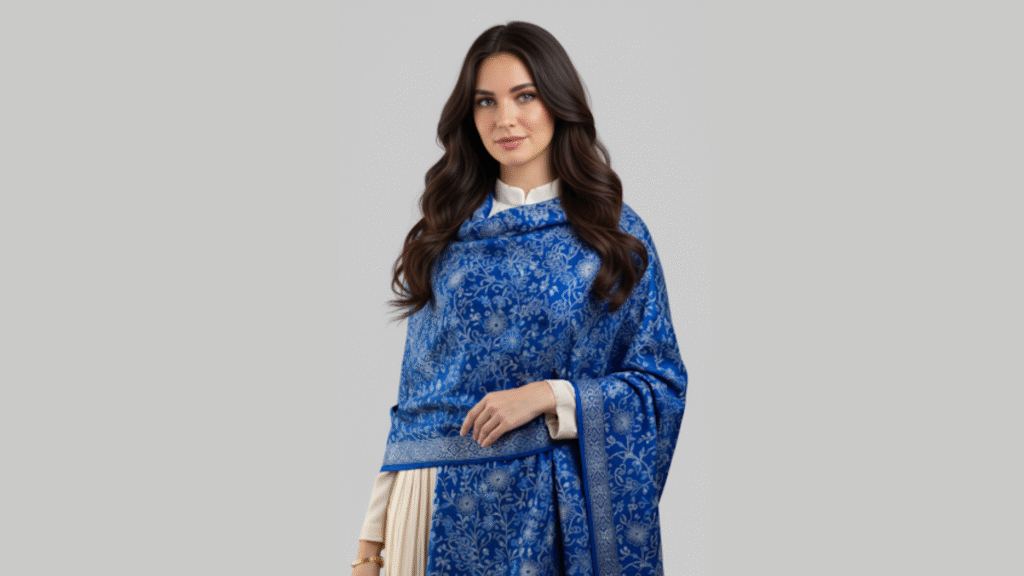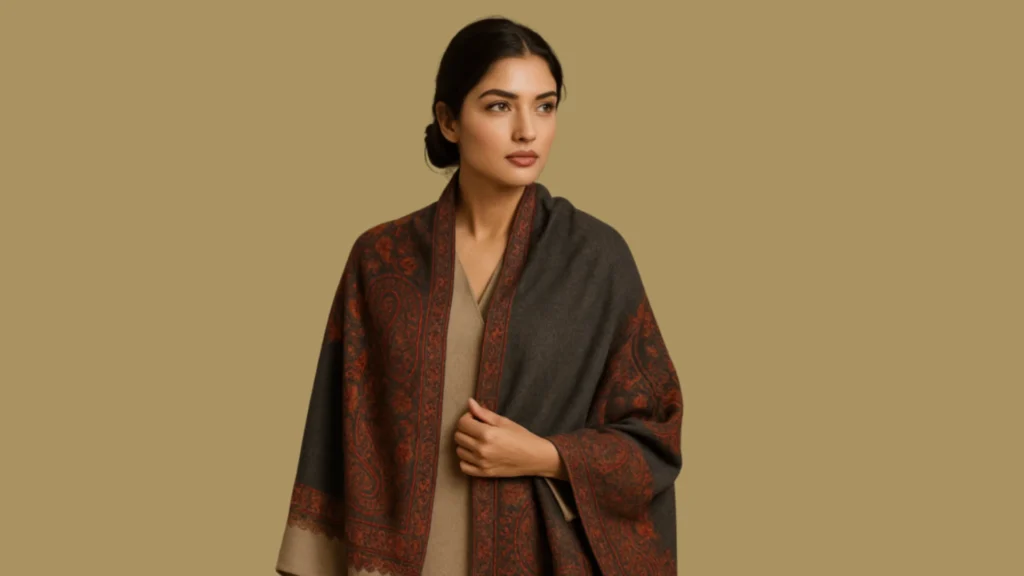From the high winds of Ladakh to the looms of Kashmir, few textiles carry a legacy as cherished as pashmina. Yet its reputation has made it one of the most counterfeited fabrics, with shiny blends and machine-made imitations often misleading buyers about what they are truly purchasing. The result? A heritage craft reduced to confusion and compromise, making it vital to know how to identify pure pashmina shawls and invest only in true heirlooms.
And while imitations may look convincing, authentic pashmina has a language of its own, woven into every irregular edge, felt in its feather-light warmth, and preserved through centuries of Kashmiri craftsmanship. Learning to read these signs not only protects you from replicas, it connects you directly to the legacy of artisans who have kept this heirloom craft alive for generations.
In this guide, we’ll walk you through the essential tests and tell-tale details that distinguish genuine pashmina from lookalikes, so you can choose with confidence and carry forward a piece of living heritage.
Why authentic pashmina matters
Authentic pashmina comes from the undercoat of the Changthangi goat, a breed native to the high-altitude regions of Ladakh. These fibers are extremely fine, measuring around 12-16 microns in diameter, and are hand-gathered and hand-spun by Kashmiri artisans.
Synthetic imitations, often labeled as “pashmina” or “cashmere,” are usually made from acrylic, viscose, or other artificial fibers. These materials can mimic the look and feel of real pashmina to some extent but lack its natural warmth, breathability, and texture.
True pashmina weaving and embroidery represent skills passed down for generations in Kashmir. When you find genuine pashmina, you’re holding something that connects directly to this heritage.
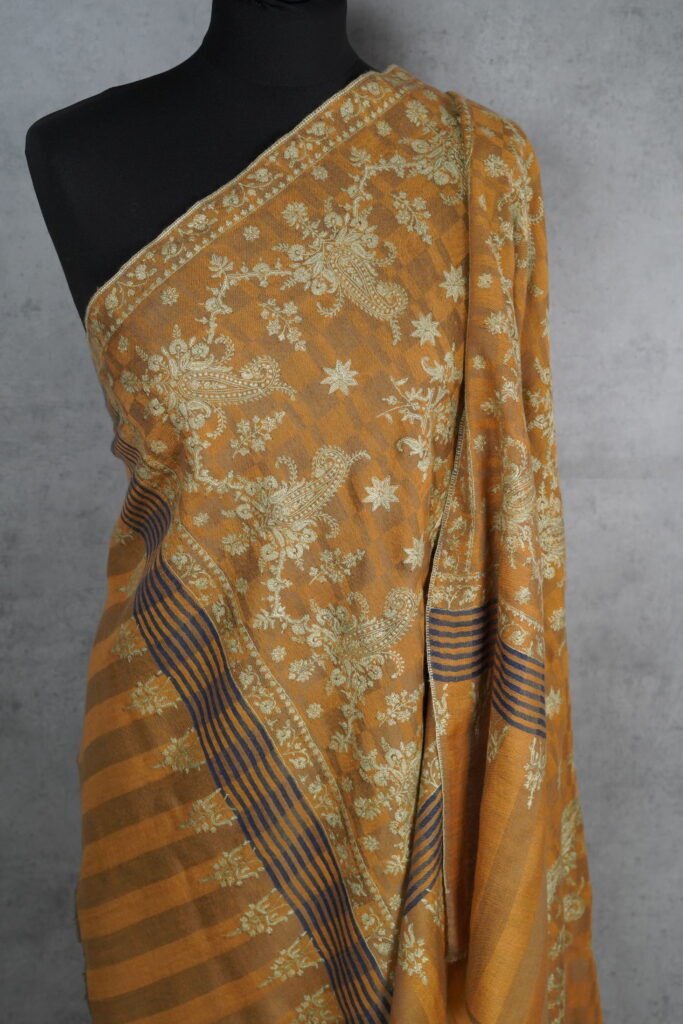
Handwoven signs every genuine shawl shows
Handwoven pashmina shawls display features that don’t appear in machine-made fabrics. These indicators can be seen by carefully observing the edges and any embroidery work.
Loom selvedge imperfections
The edges, known as selvedges, on a handwoven pashmina shawl often appear slightly uneven. Small variations in thickness or waviness occur because the yarn is managed by hand on a traditional loom.
These natural shifts in structure are part of the hand-weaving process and won’t be found in machine-woven textiles, which have perfectly uniform edges.
Uneven sozni knot density
Sozni embroidery, done entirely by hand, shows minor differences in the spacing and tension of the stitches. Some knots or threads may be closer together or slightly looser, creating gentle irregularities across the pattern.
This variation reflects the unique hand movements of each artisan and proves the embroidery was crafted by a person, not a machine.
Delicate openness in the weave
Hold a handwoven pashmina against the light, and you will see a fine, airy structure. The threads reveal tiny, irregular gaps, proof of hand tension guiding the loom. Machine-woven fabrics often appear dense and overly rigid, lacking this natural breathability.
Feathered warp-end fringe (eyelash finish)
On classic Kashmiri pashmina, the “fringe” is simply the warp threads released from the loom: fine, hair-like ends that are trimmed and lightly teased, not twisted or knotted. They look soft, naturally feathered, and slightly varied in length. By contrast, machine pieces usually show perfectly uniform, heat-cut hems or bundled, identical tassels, missing this organic, eyelash-like finish.
Step-by-Step Tests on How to Identify a Pure Pashmina Shawl : Real vs Fake
A genuine pashmina reveals itself through a handful of simple, sensory checks—touch, sight, smell, and even sound—performed before you ever look at a price tag.
The ring test
Genuine pashmina is made from very fine fibers, which allows a shawl to slip smoothly through a standard wedding ring. Some fabric blends and lightweight machine-made shawls can also pass this test, so it’s not a complete guarantee of authenticity on its own.
The burn test
A small, loose thread from genuine pashmina, when burned safely, produces an odor similar to burnt hair and leaves behind a soft, powdery ash.
- Synthetic materials: Tend to melt, harden, or give off a chemical smell
- Real pashmina: Burns like hair and creates fine ash
- Safety note: Only test a single thread from the fringe area
The static test
Rubbing two sections of a real pashmina shawl together does not create static electricity. Synthetic fibers often generate sparks or static when rubbed, attracting small particles like dust.
This happens because natural animal fibers don’t build up electrical charge the way synthetic materials do.
Weave irregularity check
Handwoven pashmina typically displays small irregularities in the weave, such as slight variations in spacing or texture. These imperfections come from the manual process of weaving on traditional looms.
Machine-made shawls have a perfectly uniform weave and even edges throughout the entire piece.
Understanding micron science and fiber origins
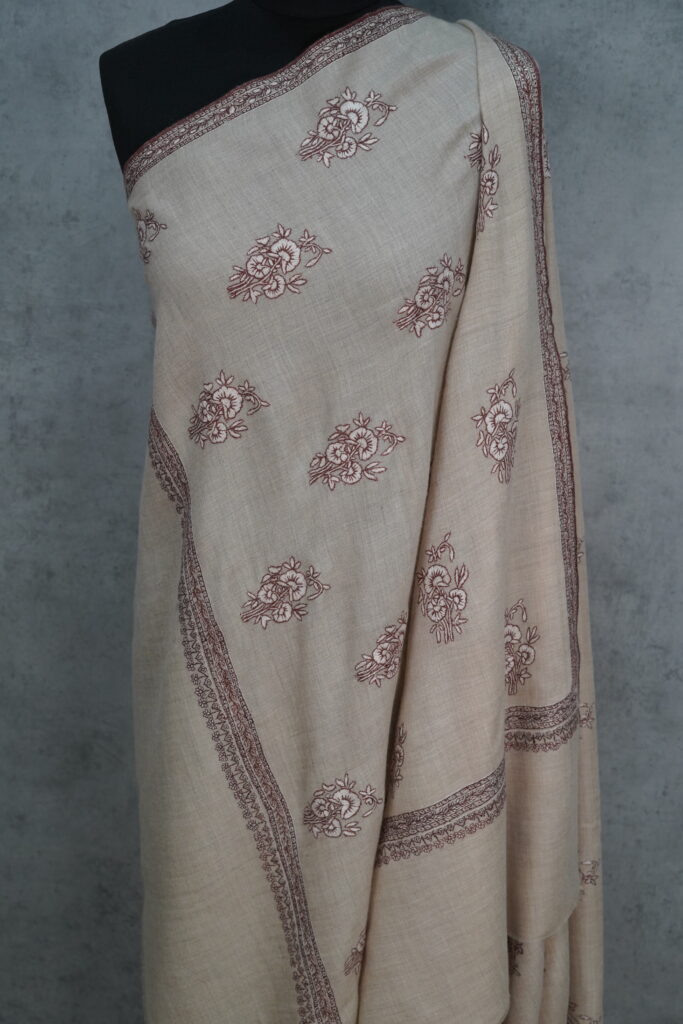
Diameter in microns
Genuine pashmina fibers measure between 12 and 16 microns in diameter. This measurement refers to the thickness of each individual fiber.
For comparison:
- Standard cashmere fibers: 16-19 microns
- Sheep’s wool: Often 20+ microns
- Human hair: Around 50-100 microns
The smaller the micron count, the finer and softer the fiber feels. Pashmina’s low micron diameter creates its characteristic lightness and warmth without weight.
Changthangi goat undercoat
Pashmina comes from the undercoat of the Changthangi goat, a breed native to the Ladakh region in the Himalayas. These goats grow a dense, fine underlayer of wool during cold seasons to protect themselves from harsh mountain temperatures.
This undercoat is collected each spring through a gentle combing process, not shearing. The climate, altitude, and traditional care practices in Ladakh directly affect the quality and fineness of the fiber. Only fiber from this specific breed and region counts as authentic pashmina.
Common myths that mislead pashmina buyers
Ring test is foolproof myth
The ring test is widely used to identify pashmina. In this test, a shawl is passed through a small ring, like a wedding ring. While genuine pashmina is fine enough to fit, some synthetic blends and lightweight machine-made fabrics can also pass through a ring.
The ring test alone doesn’t confirm authenticity. Multiple tests together offer clearer results.
Shine equals quality myth
Authentic pashmina has a matte or slightly lustrous finish because it’s made from natural animal fibers. Synthetic and viscose materials often look shiny or reflect light more strongly.
High shine is usually a sign of imitation or blended fabric, not pure pashmina.
Where to buy certified pashmina with confidence
Government GI certified stores
The Government of India has established Geographical Indication (GI) certification for pashmina products. GI tags identify products that originate from a specific place and meet set standards for quality and authenticity.
GI-certified pashmina is made from the undercoat of the Changthangi goat and is processed, spun, and woven in Kashmir and Ladakh. The Craft Development Institute (CDI) in Srinagar issues these tags and maintains records of approved weavers and manufacturers.
Look for these authenticity markers:
- Hologram or serial number: Official certificates include verification features
- Stitched labels: Authentic tags are sewn, not glued onto the fabric
- Government database: Tag numbers can be cross-checked with issuing authorities
Artisan-led boutiques like Kashmir Bloom
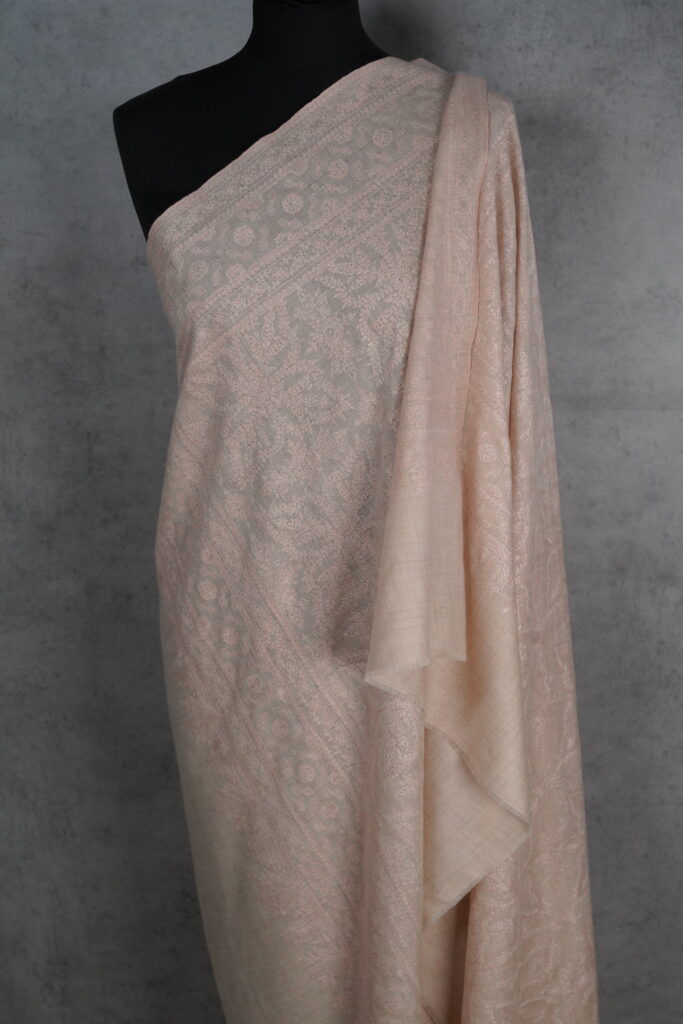
From our heritage showroom at 1532 Pershore Rd, Stirchley, Birmingham, B30 2NW, Kashmir Bloom continues the journey of authentic pashmina from Ladakh’s highlands and Kashmir’s looms to discerning admirers across the world.
Unlike boutiques that only claim transparency, we go further, maintaining direct relationships with artisan families and documenting every stage of a shawl’s journey, from the Changthangi goat’s undercoat to the final handwoven masterpiece.
- Fiber clarity: Exact composition and micron fineness openly disclosed.
- Origin traceability: Raw material sourcing from Ladakh detailed with care.
- Craft transparency: Dyeing, spinning, weaving, and embroidery steps documented.
- Heritage assurance: Each piece comes with provenance notes that connect buyer to artisan.
This rooted presence, both in Kashmir’s heritage and here in Birmingham, is why heritage lovers and collectors trust us to deliver not just a shawl, but an heirloom of uncompromised integrity.
Care tips to keep your pure pashmina pristine
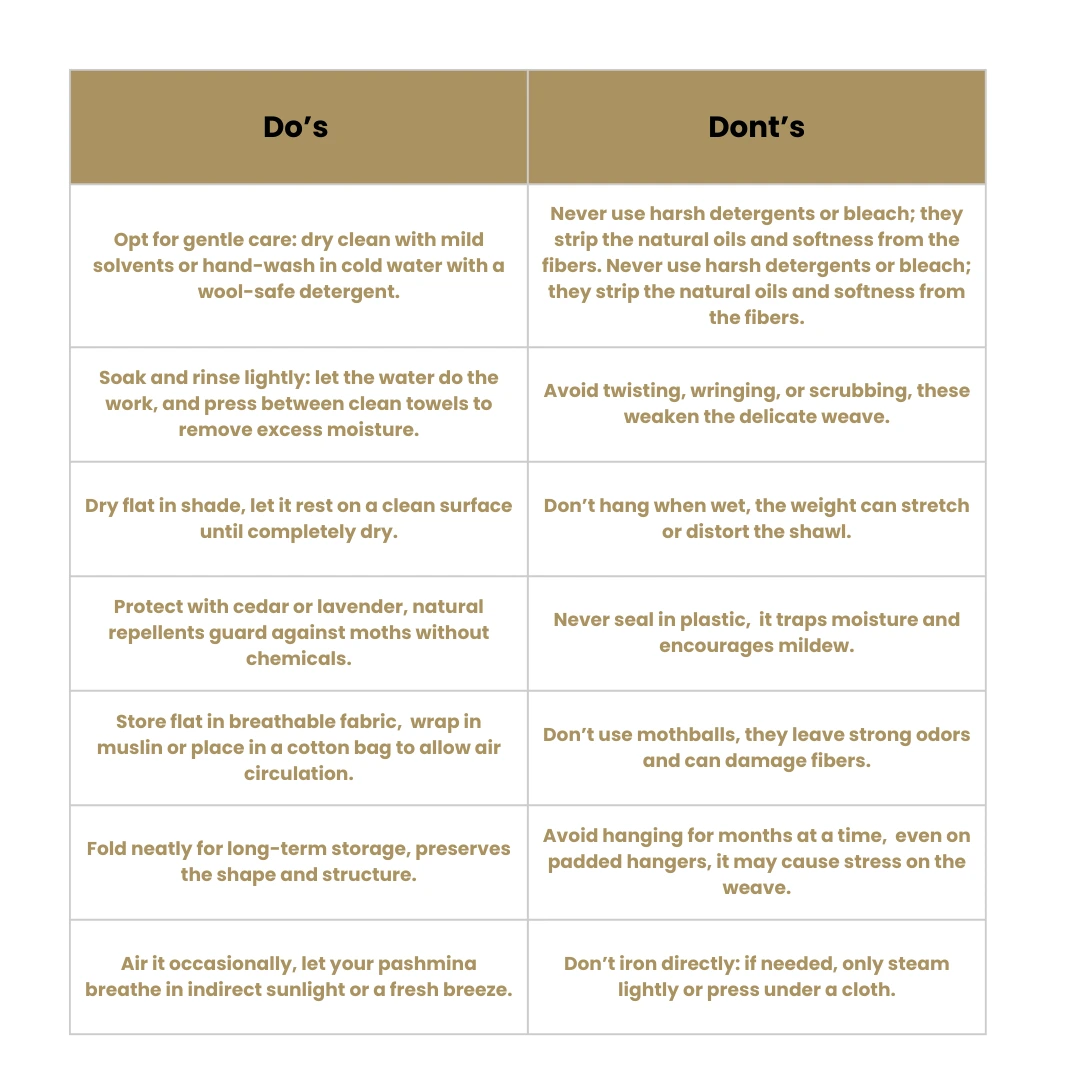
Own a story, not just a Pashmina shawl
A Kashmir Bloom pashmina is not just an accessory, it is a companion for life’s moments, carrying warmth, elegance, and meaning wherever it goes. Its softness endures through seasons, its design transcends fleeting trends, and its value only deepens as it becomes part of your story.
At Kashmir Bloom, we exist to preserve this legacy while offering you pieces that embody both timeless beauty and modern sophistication. Each shawl is an invitation to experience the rare harmony of heritage and luxury, crafted by Kashmiri artisans, cherished by those who understand true artistry, and destined to be passed down as an heirloom for generations.
For those interested in viewing handwoven pashmina with full documentation, Kashmir Bloom offers private appointments and consultations about the Heirloom Edit collection at kashmirbloom.com/shop/.
Frequently Asked Questions on How to Identify a Pure Pashmina Shawl
1. Can machine-made pashmina shawls still be authentic?
Machine-woven pashmina using genuine Changthangi goat fiber can be authentic, though traditional handwoven pieces are considered more valuable due to their artisanal craftsmanship.
2. Does authentic pashmina always come with a GI certification tag?
Not all genuine pashmina carries official GI tags, as some artisans work outside the formal certification system, but GI tags provide the strongest guarantee of authenticity and origin.
3. How much does authentic pashmina typically cost?
The price of an authentic Pashmina can vary depending on its quality, size, and craftsmanship. A simple handwoven stole may start around £40–£150, while a solid-colour genuine shawl usually costs between £200–£300.
More detailed designs and larger handcrafted pieces often range from £300–£1,200, and intricately embroidered styles such as Sozni or Kani can reach £500–£2,500. Rare collector’s items or heirloom-quality Pashminas, prized for their artistry and heritage, may command prices of £1,500–£12,000 or more.
4. Is the ring test enough to confirm a shawl is pure pashmina?
No. While many authentic pashminas pass the ring test, fine silk and some synthetic blends can pass too. Combine the ring test with other checks—soft warmth against the skin, slight weave irregularities, absence of static, and an official GI tag—for reliable proof.
5. Is pashmina the same as cashmere?
Pashmina is a special, finer grade of cashmere. It is combed from Changthangi goats and measures only 12–16 microns in diameter, giving it exceptional lightness and softness. Standard cashmere can be thicker and sourced from several goat breeds, so it may not feel as airy or rare as true pashmina.




